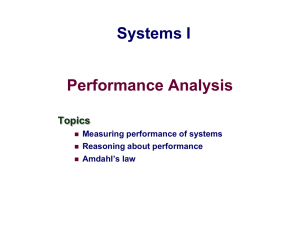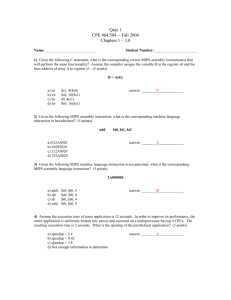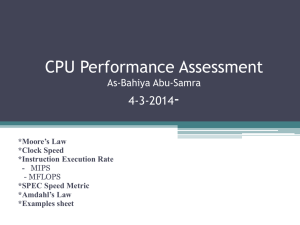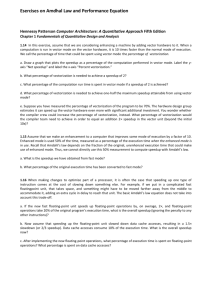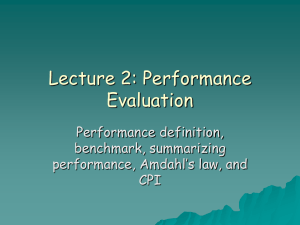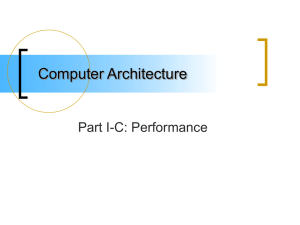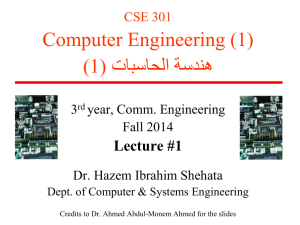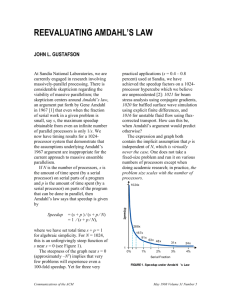PPT - ECE/CS 552 Fall 2010 - University of Wisconsin
advertisement
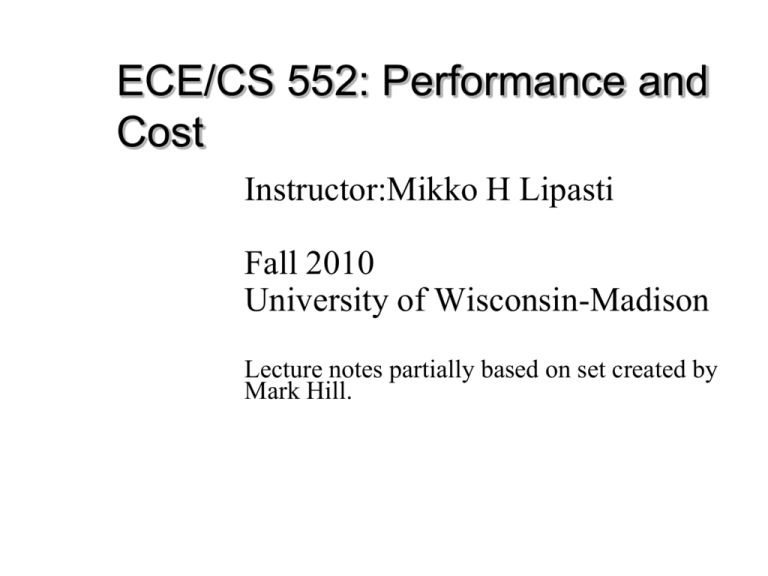
ECE/CS 552: Performance and Cost Instructor:Mikko H Lipasti Fall 2010 University of Wisconsin-Madison Lecture notes partially based on set created by Mark Hill. Performance and Cost Which of the following airplanes has the best performance? Airplane Passengers Boeing 737-100 Boeing 747 BAC/Sud Concorde Douglas DC-8-50 101 470 132 146 Range (mi) Speed (mph) 630 4150 4000 8720 598 610 1350 544 How much faster is the Concorde vs. the 747 How much bigger is the 747 vs. DC-8? Performance and Cost Which computer is fastest? Not so simple – Scientific simulation – FP performance – Program development – Integer performance – Database workload – Memory, I/O Performance of Computers Want to buy the fastest computer for what you want to do? – Workload is all-important – Correct measurement and analysis Want to design the fastest computer for what the customer wants to pay? – Cost is an important criterion Forecast Time and performance Iron Law MIPS and MFLOPS Which programs and how to average Amdahl’s law Defining Performance What is important to whom? Computer system user – Minimize elapsed time for program = time_end – time_start – Called response time Computer center manager – Maximize completion rate = #jobs/second – Called throughput Response Time vs. Throughput Is throughput = 1/av. response time? – – – – – – – Only if NO overlap Otherwise, throughput > 1/av. response time E.g. a lunch buffet – assume 5 entrees Each person takes 2 minutes/entrée Throughput is 1 person every 2 minutes BUT time to fill up tray is 10 minutes Why and what would the throughput be otherwise? 5 people simultaneously filling tray (overlap) Without overlap, throughput = 1/10 What is Performance for us? For computer architects – CPU time = time spent running a program Intuitively, bigger should be faster, so: – Performance = 1/X time, where X is response, CPU execution, etc. Elapsed time = CPU time + I/O wait We will concentrate on CPU time Improve Performance Improve (a) response time or (b) throughput? – Faster CPU Helps both (a) and (b) – Add more CPUs Helps (b) and perhaps (a) due to less queueing Performance Comparison Machine A is n times faster than machine B iff perf(A)/perf(B) = time(B)/time(A) = n Machine A is x% faster than machine B iff – perf(A)/perf(B) = time(B)/time(A) = 1 + x/100 E.g. time(A) = 10s, time(B) = 15s – 15/10 = 1.5 => A is 1.5 times faster than B – 15/10 = 1.5 => A is 50% faster than B Breaking Down Performance A program is broken into instructions – H/W is aware of instructions, not programs At lower level, H/W breaks instructions into cycles – Lower level state machines change state every cycle For example: – 1GHz Snapdragon runs 1000M cycles/sec, 1 cycle = 1ns – 2.5GHz Core i7 runs 2.5G cycles/sec, 1 cycle = 0.25ns Iron Law Time Processor Performance = --------------Program = Instructions Program (code size) X Cycles X Instruction (CPI) Time Cycle (cycle time) Architecture --> Implementation --> Realization Compiler Designer Processor Designer Chip Designer Iron Law Instructions/Program – Instructions executed, not static code size – Determined by algorithm, compiler, ISA Cycles/Instruction – Determined by ISA and CPU organization – Overlap among instructions reduces this term Time/cycle – Determined by technology, organization, clever circuit design Our Goal Minimize time which is the product, NOT isolated terms Common error to miss terms while devising optimizations – E.g. ISA change to decrease instruction count – BUT leads to CPU organization which makes clock slower Bottom line: terms are inter-related Other Metrics MIPS and MFLOPS MIPS = instruction count/(execution time x 106) = clock rate/(CPI x 106) But MIPS has serious shortcomings Problems with MIPS E.g. without FP hardware, an FP op may take 50 single-cycle instructions With FP hardware, only one 2-cycle instruction Thus, adding FP hardware: – CPI increases (why?) – Instructions/program decreases (why?) – Total execution time decreases BUT, MIPS gets worse! 50/50 => 2/1 50 => 1 50 => 2 50 MIPS => 2 MIPS Problems with MIPS Ignores program Usually used to quote peak performance – Ideal conditions => guaranteed not to exceed! When is MIPS ok? – Same compiler, same ISA – E.g. same binary running on AMD Phenom, Intel Core i7 – Why? Instr/program is constant and can be ignored Other Metrics MFLOPS = FP ops in program/(execution time x 106) Assuming FP ops independent of compiler and ISA – Often safe for numeric codes: matrix size determines # of FP ops/program – However, not always safe: Missing instructions (e.g. FP divide) Optimizing compilers Relative MIPS and normalized MFLOPS – Adds to confusion Rules Use ONLY Time Beware when reading, especially if details are omitted Beware of Peak – “Guaranteed not to exceed” Iron Law Example Machine A: clock 1ns, CPI 2.0, for program x Machine B: clock 2ns, CPI 1.2, for program x Which is faster and how much? Time/Program = instr/program x cycles/instr x sec/cycle Time(A) = N x 2.0 x 1 = 2N Time(B) = N x 1.2 x 2 = 2.4N Compare: Time(B)/Time(A) = 2.4N/2N = 1.2 So, Machine A is 20% faster than Machine B for this program Iron Law Example Keep clock(A) @ 1ns and clock(B) @2ns For equal performance, if CPI(B)=1.2, what is CPI(A)? Time(B)/Time(A) = 1 = (Nx2x1.2)/(Nx1xCPI(A)) CPI(A) = 2.4 Iron Law Example Keep CPI(A)=2.0 and CPI(B)=1.2 For equal performance, if clock(B)=2ns, what is clock(A)? Time(B)/Time(A) = 1 = (N x 2.0 x clock(A))/(N x 1.2 x 2) clock(A) = 1.2ns Which Programs Execution time of what program? Best case – your always run the same set of programs – Port them and time the whole workload In reality, use benchmarks – – – – Programs chosen to measure performance Predict performance of actual workload Saves effort and money Representative? Honest? Benchmarketing… How to Average Program 1 Machine A 1 Machine B 10 Program 2 1000 100 Total 1001 110 One answer: for total execution time, how much faster is B? 9.1x How to Average Another: arithmetic mean (same result) Arithmetic mean of times: n 1 time(i ) AM(A) = 1001/2 = 500.5 i 1 n AM(B) = 110/2 = 55 500.5/55 = 9.1x Valid only if programs run equally often, so use weighted arithmetic mean: n 1 weight (i ) time(i ) i 1 n Other Averages E.g., 30 mph for first 10 miles, then 90 mph for next 10 miles, what is average speed? Average speed = (30+90)/2 WRONG Average speed = total distance / total time = (20 / (10/30 + 10/90)) = 45 mph Harmonic Mean n n 1 i 1 rate( n) Harmonic mean of rates = Use HM if forced to start and end with rates (e.g. reporting MIPS or MFLOPS) Why? – Rate has time in denominator – Mean should be proportional to inverse of sums of time (not sum of inverses) – See: J.E. Smith, “Characterizing computer performance with a single number,” CACM Volume 31 , Issue 10 (October 1988), pp. 1202-1206. Dealing with Ratios Program 1 Program 2 Total Machine A 1 1000 1001 Machine B 10 100 110 If we take ratios with respect to machine A Program 1 Machine A 1 Machine B 10 Program 2 1 0.1 Dealing with Ratios Average for machine A is 1, average for machine B is 5.05 If we take ratios with respect to machine B Program 1 Program 2 Average Machine A 0.1 10 5.05 Machine B 1 1 1 Can’t both be true!!! Don’t use arithmetic mean on ratios! Geometric Mean Use geometric mean for ratios Geometric mean of ratios = n n ratio(i) i 1 Independent of reference machine In the example, GM for machine a is 1, for machine B is also 1 – Normalized with respect to either machine But… GM of ratios is not proportional to total time AM in example says machine B is 9.1 times faster GM says they are equal If we took total execution time, A and B are equal only if – Program 1 is run 100 times more often than program 2 Generally, GM will mispredict for three or more machines Summary Use AM for times Use HM if forced to use rates Use GM if forced to use ratios Best of all, use unnormalized numbers to compute time Benchmarks: SPEC2000 System Performance Evaluation Cooperative – Formed in 80s to combat benchmarketing – SPEC89, SPEC92, SPEC95, SPEC2000 12 integer and 14 floating-point programs – Sun Ultra-5 300MHz reference machine has score of 100 – Report GM of ratios to reference machine Benchmarks: SPEC CINT2000 Benchmark 164.gzip 175.vpr 176.gcc 181.mcf 186.crafty 197.parser 252.eon 253.perlbmk 254.gap 255.vortex 256.bzip2 300.twolf Description Compression FPGA place and route C compiler Combinatorial optimization Chess Word processing, grammatical analysis Visualization (ray tracing) PERL script execution Group theory interpreter Object-oriented database Compression Place and route simulator Benchmarks: SPEC CFP2000 Benchmark 168.wupwise 171.swim 172.mgrid 173.applu 177.mesa 178.galgel 179.art 183.equake 187.facerec 188.ammp 189.lucas 191.fma3d 200.sixtrack 301.apsi Description Physics/Quantum Chromodynamics Shallow water modeling Multi-grid solver: 3D potential field Parabolic/elliptic PDE 3-D graphics library Computational Fluid Dynamics Image Recognition/Neural Networks Seismic Wave Propagation Simulation Image processing: face recognition Computational chemistry Number theory/primality testing Finite-element Crash Simulation High energy nuclear physics accelerator design Meteorology: Pollutant distribution Benchmark Pitfalls Benchmark not representative – Your workload is I/O bound, SPEC is useless Benchmark is too old – Benchmarks age poorly; benchmarketing pressure causes vendors to optimize compiler/hardware/software to benchmarks – Need to be periodically refreshed Amdahl’s Law Motivation for optimizing common case Speedup = old time / new time = new rate / old rate Let an optimization speed fraction f of time by a factor of s 1 f f oldtime Speedup f 1 f oldtime oldtime s 1 f 1 f s Amdahl’s Law Example Your boss asks you to improve performance by: – Improve the ALU used 95% of time by 10% – Improve memory pipeline used 5% of time by 10x Let f=fraction sped up and s = speedup on that fraction New_time = (1-f) x old_time + (f/s) x old_time Speedup = old_time / new_time Speedup = old_time / ((1-f) x old_time + (f/s) x old_time) Amdahl’s Law: Speedup 1 1 f f s Amdahl’s Law Example, cont’d f s Speedup 95% 1.10 1.094 5% 10 1.047 5% ∞ 1.052 Amdahl’s Law: Limit 1 lim s f 1 f Make common case fast: 1 f s Speedup 1 10 9 8 7 6 5 4 3 2 1 0 0 0.2 0.4 0.6 f 0.8 1 Amdahl’s Law: Limit Consider uncommon case! If (1-f) is nontrivial – Speedup is limited! 1 1 lim s f 1 f 1 f s Particularly true for exploiting parallelism in the large, where large s is not cheap – – – – GPU with e.g. 1024 processors (shader cores) Parallel portion speeds up by s (1024x) Serial portion of code (1-f) limits speedup E.g. 10% serial limits to 10x speedup! Summary Time and performance: Machine A n times faster than Machine B – Iff Time(B)/Time(A) = n = Iron Law: Performance = Time/program = Instructions Program (code size) X Cycles X Instruction (CPI) Time Cycle (cycle time) Summary Cont’d Other Metrics: MIPS and MFLOPS – Beware of peak and omitted details Benchmarks: SPEC2000 Summarize performance: – AM for time – HM for rate – GM for ratio Amdahl’s Law: Speedup 1 f 1 f s
